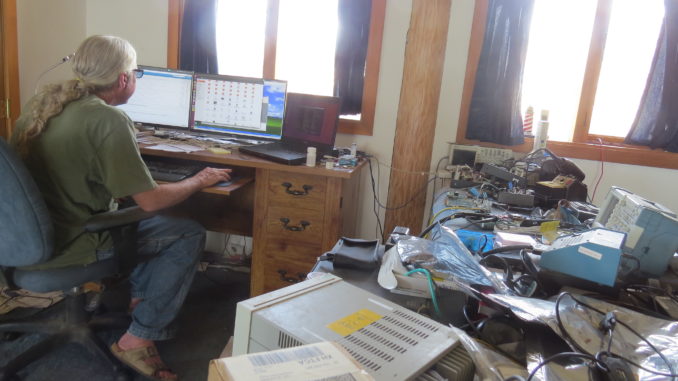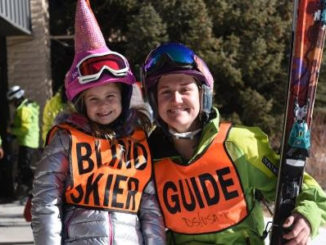
by Matt Bartmann
North Forty News
With his long white ponytail, Tim Starkweather of Larimer County looks like a hippie. But there’s no “slacker” stereotype about this guy. When it comes to work, he’s laser-focused.
Only one detour is invited at the remote log home west of Fort Collins where he lives with his wife, Mary, and son, Donovan. “Come over here, I’ll show you how close the fire got,” he says, pointing out the marks left by flames under their deck. Perched high in the foothills, surrounded by burned trees, their home narrowly escaped the High Park Fire of 2012.
Then it’s time to get to the work he’s excited about. “Upstairs is where I have my ‘lab,’ ” says Starkweather, leading the way past haphazard stacks of framed documents at the foot of a staircase. “Oh, those are my patents,” he says off-handedly, brushing past them. How many? “Somewhere around 37,” he shrugs, eager to get to the “lab” upstairs.

Inventor Tim Starkweather keeps an eye on things from his remote home high in the foothills.
Starkweather is a computer-coding genius, and the inventions he’s been involved with are already successfully in use worldwide. His career in the field began with pacemakers and implantable defibrillators, now commonplace, then moved to an implantable insulin pump, cochlear implants for the deaf, and, most recently, implants that help to restore sight. “I like helping people,” he says, simply.
His “lab equipment”? A table full of electronic test equipment and a couple of computers, on which he writes the code and does testing on the devices. “Yeah, it’s enough to keep you busy,” he laughs, looking over his work area.
Starkweather, who earned his Ph.D. in computer science at CSU in 1993, is currently the Chief Engineer of Embedded Systems at Second Sight Medical Products, Inc., of Sylmar, California (http://secondsight.com), with whom he’s been working on a “bionic eye” for about 10 years.
The “retinal prosthethic” he’s helped bring to life is already in use worldwide, in hundreds of people in the U.S., as well as in “all EU (European Union) states, Russia, Saudi Arabia, Taiwan, and other countries.”
Approved by the FDA for use in patients with retinitis pigmentosa (RP), one of the most common degenerative eye diseases, the device is only for people who have “intact ganglial cells and a good optic nerve”—those who have been able to see in the past, not those who have been blind since birth.
The resulting vision is not nearly on a par with normal human vision. Still, it makes a huge difference in quality of life by allowing formerly blind people to follow a path, see the white lines in a crosswalk, or know the location of a window. Those with the device can engage in “basic locomotion” without needing assistance, a big boost to independence in daily life, says Starkweather.
“It’s pretty emotional,” he says about witnessing the reaction of patients who have received the device.
The device consists of three components: the surgically implanted retinal prosthetic; a pair of special glasses with a tiny video camera in the frames; and a patient-worn computer that receives and processes the video signal.
The retinal prosthetic, which includes a computer chip that holds Starkweather’s coding (“tons and tons of it, because it has to handle all of the video processes and run all the time” the glasses are in use), is connected to 60 tiny electrodes implanted behind the retina.
Those electrodes receive the images transmitted by the glasses—the former function of the failed retina that caused the visual impairment—and the patient-worn computer wirelessly translates it into “sight.”
As complex as the bionic eye is, it’s nowhere near as complicated as the human eye, which has about 10 million photoreceptors and streams information from about 1 million of them to the optic nerve.
Starkweather and the team—“material scientists, mechanical engineers, electrical engineers, electrochemists, and lots of other support”—are constantly working on improvements to boost the sensitivity of the device. They hope to use 240 electrodes, four times the current 60, and engineer them so that a group of electrodes works in unison in reaction to an electrical pulse, instead of only one, as is currently the case.
Implanting electrodes into the optical cortex of the brain itself, while still using a camera to provide “vision,” is another idea being investigated and has now received approval for an initial clinical trial. This is “a huge deal,” enthuses Starkweather, because it has the potential to treat all forms of blindness encountered in adulthood.
Scientist/hippie Starkweather commutes as needed between his remote home and lab in the foothills of Larimer County and Second Sight in big city Los Angeles. “It’s one of the really bizarre things about my lifestyle. I fly out, get a car, drive on freeways with six lanes of traffic each way….” he says, shaking his head. “After I’m out there, I can’t wait to get home.”
For more about Second Sight’s retinal prosthetic, see http://secondsight.com/g-the-argus-ii-prosthesis-system-pf-en.html
Support Northern Colorado Journalism
Show your support for North Forty News by helping us produce more content. It's a kind and simple gesture that will help us continue to bring more content to you.
BONUS - Donors get a link in their receipt to sign up for our once-per-week instant text messaging alert. Get your e-copy of North Forty News the moment it is released!
Click to Donate


1 Trackback / Pingback
Comments are closed.